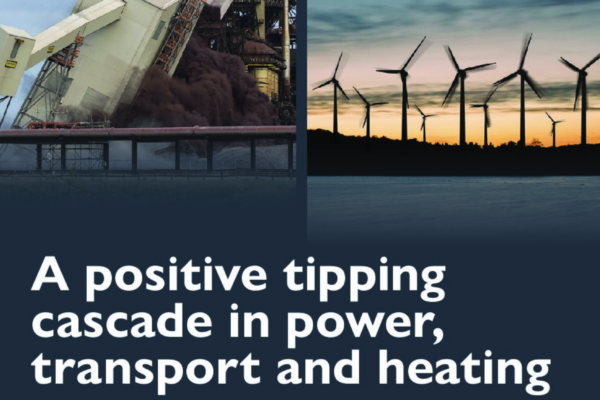Our projects
We have a particular focus on the power, road transport, and steel sectors. We also support the development and use of analytical tools appropriate for use in contexts of structural change.

Explore our projects
Economics of Energy Innovation and System Transition

Modelling transitions and tipping points in power, transport, and industry
The Economics of Energy Innovation and System Transition (EEIST) project is currently focused on modelling the transitions to clean technologies in heavy road transport, steel, and hydrogen production. Together with our academic partners, we use a dynamic model to simulate the effects of alternative policy options. We have also studied tipping points in the transitions towards solar power and storage, electric vehicles, green hydrogen, heat pumps, and alternative proteins, and the potential for policy to activate a cascade of positive tipping points across sectors.
In its earlier phase, the EEIST project produced reports on decision-making frameworks, principles for policymaking, and modelling for the low carbon transition, as well as a range of policy briefs. These materials were created in partnership between researchers in the UK, China, India, and Brazil, and are available at eeist.co.uk
Current Partners: University of Exeter, World Resources Institute India, Cambridge Econometrics
This project is funded by the UK Department for Energy Security and Net Zero.
Systems mapping for power sector reform in China

Understanding interactions between policies, technologies and markets in the transition to clean power
The direction of change in the power sector is clear – from coal and gas to solar and wind, as the dominant technologies – but how to achieve that change quickly and cost effectively, while keeping electricity prices low and security of supply high, is less obvious. Policies and market reforms aimed at achieving each of the traditional ‘trilemma’ objectives have overlapping effects. We use systems mapping with causal loop diagrams to understand the feedbacks created by these interactions, and to identify high leverage points of intervention. This project is part of the Economics of Energy Innovation and System Transition programme.
Partners: University College London, Energy Research Institute of the Chinese Academy of Macroeconomic Research, Tsinghua University, Beijing Normal University, Oxford University, World Resources Institute China
This project is co-funded by Quadrature Climate Foundation and the UK Department for Energy Security and Net Zero.
Breakthrough Agenda Policy
Network

Forging a common vision for more effective climate change diplomacy, starting with a focus on steel and trade
For over thirty years, climate change diplomacy has focused mainly on emissions targets. There are good reasons to believe that a focus on coordinated practical actions in each of the emitting sectors could be more effective, making low carbon transitions faster, less difficult, and lower cost. Countries that together account for over 80% of global GDP are participating in the Breakthrough Agenda, a process designed to strengthen practical international cooperation in each sector, but this potential remains far from fully exploited.
The Breakthrough Agenda Policy Network is a group of institutes in eight countries and regions that will conduct joint research and analysis of opportunities for international cooperation to overcome difficult problems in the low carbon transition. In its first year, the Network will focus on the role of trade in the transition to clean steel. We coordinate and provide the secretariat of the Network.
Partners: African Centre for Economic Transformation, Chatham House (UK), Council on Energy, Environment and Water (India), Energy Foundation China, Institute for Climate and Society (Brazil), Institute for Global Environmental Strategies (Japan), Institute for Sustainable Development and International Relations (France).
This project is funded by Energy Foundation China.
Coalition for Capacity on Climate Action (C3A)

Empowering Ministries of Finance to respond effectively to climate change and the low carbon transition
Ministries of Finance have much at stake in the low carbon transition, given its large potential implications for public spending, consumer costs, national economic competitiveness, trade, productivity and growth. Along with the rest of government and society, they also have an interest in limiting the economic damage done by climate change.
The Coalition for Capacity on Climate Action (C3A) is an initiative hosted by the World Bank which aims to support Ministries of Finance in responding effectively to the threat of climate change and the risks and opportunities of the low carbon transition. The initiative promotes peer-to-peer learning and research-to-policy knowledge sharing on policies and analytical tools. We coordinate C3A’s work on the theme of innovation.
Further information, including a full list of partners, is available at www.climatecapacitycoalition.
These projects and their publications represent the views of their authors, and should not be taken to represent the views of any of their funders.
'The economy isn’t just a container for its technologies; the economy emerges from its technologies.'
W. Brian Arthur
Economist and complexity scientist
More from s-curve

What we do
We produce analysis to inform action on the low carbon transition, using economic concepts and tools consistent with the context of rapid innovation and deep structural change. We also provide guidance and tools for others to use in making their own analysis.

Our team
We are a small team with leadership experience in climate change policy, diplomacy, consultancy and research. We work at the research-policy interface, collaborating with governments, research institutes, and sector-expert organisations.

Latest Publications
'A positive tipping cascade in power, transport and heating’ identifies super-leverage points in the low carbon transition. ‘Positive tipping points: five case studies to accelerate the low carbon transition’ gives more examples.
